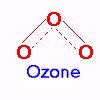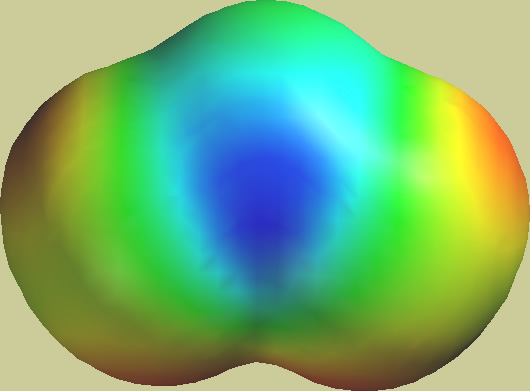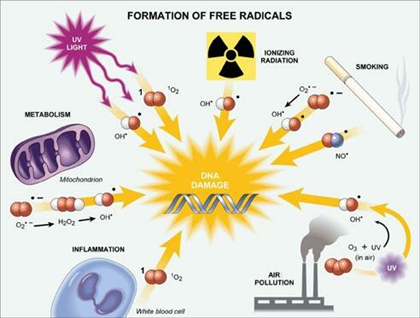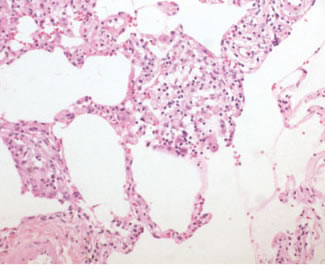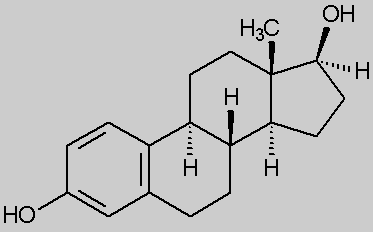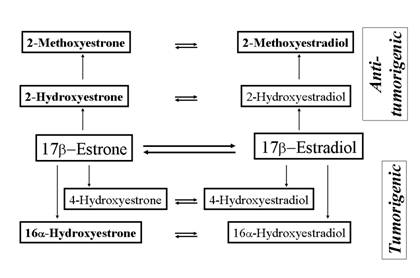In the stratosphere, ozone protects the earth from the sun's harmful UV rays. Image from http://www.unep.org/Ozone/slideshow/images/ozone-cartoons_03_0001_jpg.jpg |
Ozone is resonance-stabilized molecule. However, it is very unstable because of its peroxy bonds. Image from http://www.chm.bris.ac.uk/motm/ozone/ozone.jpg |
Ozone is an extremely electronegative species, making it a very strong oxidizing agent. Image from http://academic.reed.edu/chemistry/roco/Resonance/images/ozone_pot.jpg |
Effect of Ozone on Lung Tissue
|
Ozone and the Inflammatory Response
|
The lung is a complex organ designed to maximize the surface area for gas exchange. Image from http://z.about.com/f/p/440/graphics/images/en/1103.jpg |
There are more than 40 unique types of cells in the lung. Above is a picture of type two alveoli cells: these cells are involved in the pulmonary immune response and repair. Image from http://www.lehigh.edu/~influids/images/cagatay/figure3.JPG |
Many environmental factors can cause cellular damage, including ozone and the inflammatory response itself. Image from http://www.smokersrx.com/images/why2.jpg |
The alveoli are very delicate, as illustrated by the above picture. Image from http://oac.med.jhmi.edu/res_phys/Encyclopedia/Alveoli/AlveoliCellScan.GIF |
Pulmonary inflammation can occur throughout lung tissue. Aboe is an image comparing normal bronchiole to an inflammed bronchiole. Image from http://cjcotton.files.wordpress.com/2009/03/asthma.jpg |
If the cells in the alveoli become inflammed, as in the picture above, the volume of the lumen, and consequently lung function, is decreased. Image from http://www.ehponline.org/members/2005/7727/fig2.jpg |
Estrogen is a sex hormone
|
Estrogen is a Cytoprotectant
|
Estrogen and the Immune Response
|
Structure and Metabolism of Estrogen
The stereochemistry of 17-beta estradiol is very specific and complex. Image from http://medchem.rutgers.edu/courses/graphics/estradiol.png |
The metabolism is complex and can be triggered by a multitude of factors. Image from http://www.cellscience.com/Reviews5/Estrogen1.gif |
Prostaglandin E2's role in inflammation
|
The Deleterious Side Effects of PGE2
|
Indicators that Ozone plays a role in lung disease pathogenesis
|
Indicators that Estrogen plays a role in lung disease pathogenesis
|
So far, we know that ...
|
The Experiment
|
My Hypothesis
|
Abplanalp, W., Rymaszewski, M., Adamski, J., & Subbiah, M. T. R. (1999). Evidence for interference in estradiol-17ß inactivation to estrone by oxidized low-density lipoprotein and selected lipid peroxidation products The Journal of Laboratory and Clinical Medicine., 134(3), 253-259. Adult respiratory distress syndrome (ARDS). (2006). Mosby's dictionary of medicine, nursing, & health professions (). Philadelphia, PA, USA: Elsevier Health Sciences. Angoa-Pérez, M., Jiang, H., Rodríguez, A. I., Lemini, C., Levine, R. A., & Rivas-Aracibia, S. (2006). Estrogen counteracts ozone-induced oxidative stress and nigral neuronal death. Neuroreport, 17(6), 629-629-633. Asthma. (2004). New harvard guide to women's health, the (). Cambridge, MA, USA: Harvard University Press. Balmes, J. R. (1993). The role of ozone exposure in the epidemiology of asthma. Environmental Health Perspectives Supplements, 101(4), 219-224. Blomberg, A. (2000). Airway inflammatory and antioxidant responses to oxidative and particulate air pollutants - experimental exposure studies in humans Clinical and Experimental Allergy, 30, 310-317. Brink, C. B., Pretorius, A., van Niekerk, B. P. J., Oliver, D. W., & Venter, D. P. (2008). Studies of cellular resilience and adaptation following acute and repetitive exposure to ozone in cultured human epithelial (HeLa) cells. Redox Report, 13(2), 87-100. Buchmuller-Rouiller, Y., Corradin, S. B., Smith, J., Schneider, P., Ransijn, A., Jongeneel, C. V., et al. (1995). Role of glutathione in macrophage activation: Effect of cellular clutathione depletion on nitrite production and leishmanicidal activity Cellular Immunology, 164(73-80) Chang, L. W., Chang, Y., Ho, C., Tsai, M., & Lin, P. (2007). Increase of carcinogenic risk via enhancement of cyclooxygenase-2 espression and hyroxyestradiol accumulation in human lug cells as a result of interaction between BaP and 17-beta estradiol. Carcinogenesis, Chen, C., Arjomandi, M., Balmes, J., Tager, I., & Holland, N. (2007). Effects of chronic and acute ozone exposure on lipid peroxidation and antioxidant capacity in healthy young adults. Environmental Health Perspectives, 115(12), 1732-1737. Cho, H., Morgan, D. L., Bauer, A. K., & Kleeberger, S. R. (2007). Signal transduction pathways of tumor necrosis factor-medicated lung injury induced by ozone in mice. Am J Respir Crit Care Med, 175, 829-839. Connor, L. M., Ballinger, C. A., Albrecht, T. B., & Postlethwait, E. M. (2004). Interacial phospholipids inhibit ozone-reactive absorption-mediated cytotoxicity in vitro. Am J Physiol Lung Cell Mol Physiol, 286, 1169-1178. Del Prete, S. A., Maurer, L. H., Brinck-Johnsen, T., & Sorenson, G. D. (1983). 17-ß-estradiol levels in patients with small cell carcinoma of the lung. The Journal of Steroid Biochemistry, 18(2), 195-196. Dougherty, S. M., Mazhawidza, W., Bohn, A. R., Robinson, K. A., Mattingly, K. A., Blankenship, K. A., et al. (2006). Gender difference in the activity but not expression of estrogen receptors å and ß in human lung adenocarcinoma cells. Endocrine Related Cancer, 13(1), 113. Farhat, M. Y., Abi-Younes, S., Digaan, B., Vargas, R., & Ramwell, P. W. (1996). Estradiol increases cyclic adenosine monophosphate in rat pulmonary vascular smooth muscle cells by a nongenomic mechanism The Journal of Pharmacology and Experimental Therapeutics, 276(2), 652-657. Felty, Q., & Roy, D. (2005). Mitochondrial signals to nucleus regulate estrogen-induced cell growth. Medical Hypotheses, 64, 113-141. Hayes, C. L., Spink, D. C., Spink, B. C., Cao, J. Q., Walker, N. J., & Sutter, T. R. (1996). 17ß-estradiol hydroxylation catalyzed by human cytochrome P450 1B1. Proc. Natl. Acad. Sci. USA, 93, 9776-9781. Ho, C., Ling, Y., Chang, L. W., Tsai, M., & Lin, P. (2008). 17-beta estradiol and hydroxyestradiols interact via the NF-kappa B pathway to elevate cyclooxygenase 2 expression and prostaglandin E2 secretion in human bronchial epithelial cells. Toxological Sciences, 104(2), 294-302. Hollingsworth, J. W., Kleeberger, S. R., & Foster, W. M. (2007). Ozone and pulmonary innate immunity. Proc Am Thorac Soc, 4, 240-246. Huber, J. C., Schneeberger, C., & Tempfer, C. B. (2002). Genetic modeling of estrogen metabolism as a risk factor of hormone-dependent disorders. The European Menopause Journal, 41(1), S55-S64. Jacob, D. J. Atmospheric chemisty. AccessScience@McGraw-hill () doi:DOI 10.1036/1097-8542.059100 Kathuria, H., Cao, Y., Hinds, A., Ramirez, M. I., & Williams, M. C. (2007). ERM is expressed by alveolar epithelial cells in adult mouse lung and regulates caveolin-1 transcription in mouse lung epithelial cell lines. Journal of Cellular Biochemistry, 102, 13-27. Kim, Y. J., & Chung, H. Y. (2007). Antioxidative and anti-inflammatory actions of docosahexaenoic acid and eicosapentaenoic acid in renal epithelial cells and macrophages. Journal of Medicinal Food, 10(2), 225-231. Kwong, G. N. M., Proctor, A., Billings, C., Duggan, R., Das, C., Whyte, M. K. B., et al. (2001). Increasing prevalence of asthma diagnosis and symptoms in children is confined to mild symptoms. Thorax., 56(4), 312-314. Lai, J., Cheng, Y., Chiou, H., Wu, M., Chen, C., & Lee, H. (2005). Gender difference in estrogen receptor alpha promoter hypermethylation and its prognostic value in non-small cell lung cancer. International Journal of Cancer, 117(6), 974-980. Lin, P., Chang, Y., Chen, C., Yang, W., Cheng, Y., & Chang, L. W. (2004). A comparative study on the effects of 2,3,7,8-tetrachlorodibenzo-p-dioxin polychlorinated biphenyl126 and estrogen in human bronchial epithelial cells. Toxicology and Applied Pharmacology, 195, 83-91. Lu, B., Jiang, Y. J., & Choy, P. C. (2004). 17-ß estradiol enhances prostaglandin E2 production in human U937-derived macrophages. Molecular and Cellular Biochemistry, 262(1-2), 101-110. Lung cancer. (2004). New harvard guide to women's health, the (). Cambridge, MA, USA: Harvard University Press. Moss, M., & Mannino, D. M. (2002). Race and gender differences in acute respiratory distress syndrome deaths in the united states: An analysis of multiple cause mortality data (1979-1996). Crit Care Med, 30(8), 1679-1685. Nadadur, S. S., Costa, D. L., Slade, R., Silbjoris, R., & Hatch, G. E. (2005). Acute ozone-induced differential gene expression profiles in rat lung. Environmental Health Perspectives, 113(12), 1717-1722. Omoto, Y., Kobayashi, Y., Nishida, K., Tsuchiya, E., Eguchi, H., Nakagawa, K., et al. (2001). Espression, function and clinical implications of the estrogen receptor ß in human lung cancers. Biochemical and Biophysical Research Communications, 285, 340-347. Pryor, W. A. (1994). Mechanisms of radical formation from reactions of ozone with target molecules in the lung. Free Radical Biology and Medicine, 17(5), 451-465. Quinlan, G. J., Lamb, N. J., Tilley, R., Evans, T. W., & Gutteridge, J. M. C. (1997). Plasma hypoxanthine levels in ARDS: Implications for oxidative stress, morbidity, and mortality. American Journal of Respiratory & Critical Care Medicine, 155(2), 479-484. Russo, R., Navarra, M., Maiuolo, J., Rotiroti, D., Bagetta, G., & Corasaniti, M. T. (2005). 17ß-estradiol portects SH-SY5Y cells against HIV-1 gp120-induced cell death: Evidence for a role of estrogen receptors. NeuroToxicology, 26, 905-913. Sadava, D., Heller, H. C., Orians, G. H., Purves, W. K., & Hillis, D. M. (2007). Life: The science of biology (8th edition ed.). USA: The Courier Companies, Inc. Schagat, T. L., Wofford, J. A., Greene, K. E., & Wright, J. R. (2003). Surfacant protein A differentially regulates peripheral and inflammatory neutrophil chemotaxis. AJP - Lung Cellular and Molecular Physiology, 284, L140-L147. Schatz, M., Clark, S., & Camargo, C. A. J. (2006). Sex differences in the presentation and course of asthma hospitalizations. Chest, 129, 50-55. Si, M., Al-Sharafi, B., Lai, C., Khardori, P., Chang, C., & Su, C. (2001). Gender difference in cytoprotection induced by estrogen on female and male bovine aortic endothelial cells Endocrine, 15(3), 255-262. Stenson, W. F. (2007). Prostaglandins and epithelial response to injury. Current Opinion in Gastroenterology, 23, 107-110. TenHoor, T., Mannino, D. M., & Moss, M. (2001). Risk factors for ARDS in the united states - analysis of the 1993 national mortality followback study Chest, 119, 1179-1184. Todokoro, M., Mochizuki, H., Tokuyama, K., Utsugi, M., Dobashi, K., Mori, M., et al. (2004). Effect of ozone exposure on intracellular glutathione redox state in cultured human airway epithelial cells Inflammation, 28(2), 105-114. Tsao, S., Yin, M., & Liu, W. (2007). Oxidant stress and B vitamins status in patients with non-small cell lung cancer Nutrition and Cancer, 59(1), 8-13. Urata, Y., Ihara, Y., Murata, H., Goto, S., Koji, T., Yodoi, J., et al. (2006). 17ß-estradiol protects against oxidative stress-induced cell death through the Glutathione/Glutaredoxin-dependent redox regulation of akt in myocardiac H9c2 cells. The Journal of Biological Chemistry, 281(19), 13092-13102. Wade, L. G. J. (2006). Organic chemistry (6th edition ed.). United States of America: Pearson Prentice Hall. Wang, J., Wang, S., Manzer, R., McConville, G., & Mason, R. J. (2006). Ozone induces oxidative stress in rat alveolar type II and type I-like cells. Free Radical Biology and Medicine, 40, 1914-1928. Zhu, B. T., & Conney, A. H. (1998). Function role of estrogen metabolism in target cells: Review and perspectives Carcinogenesis, 19(1), 1-27. Zhu, B. T., & Lee, A. J. (2005). NADPH-dependent metabolism of 17ß-estradiol and estrone to polar and nonpolar metabolites by human tissues and cytochrome P450 isoforms. Steroids, 70(4), 225-244.
|

